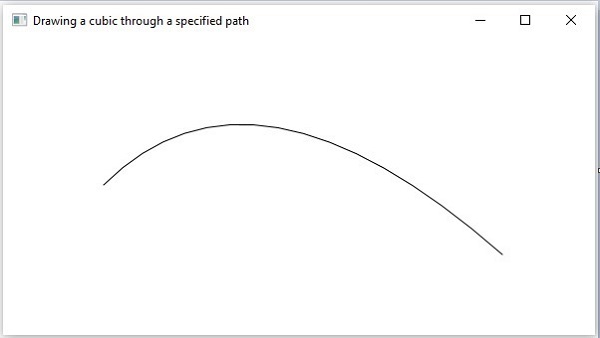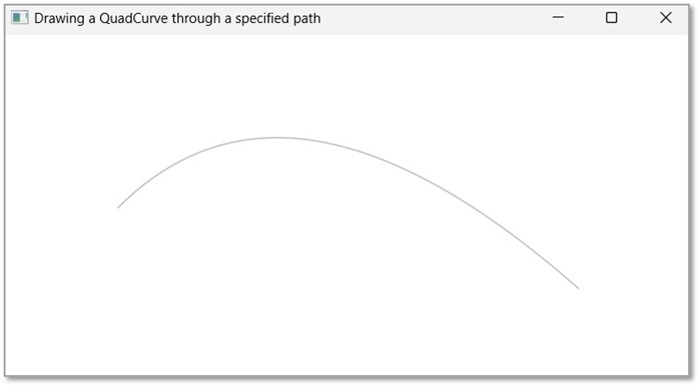
- JavaFX Tutorial
- JavaFX - Home
- JavaFX - Overview
- JavaFX Installation and Architecture
- JavaFX - Environment
- JavaFX - Installation Using Netbeans
- JavaFX - Installation Using Eclipse
- JavaFX - Installation using Visual Studio Code
- JavaFX - Architecture
- JavaFX - Application
- JavaFX 2D Shapes
- JavaFX - 2D Shapes
- JavaFX - Drawing a Line
- JavaFX - Drawing a Rectangle
- JavaFX - Drawing a Rounded Rectangle
- JavaFX - Drawing a Circle
- JavaFX - Drawing an Ellipse
- JavaFX - Drawing a Polygon
- JavaFX - Drawing a Polyline
- JavaFX - Drawing a Cubic Curve
- JavaFX - Drawing a Quad Curve
- JavaFX - Drawing an Arc
- JavaFX - Drawing an SVGPath
- JavaFX Properties of 2D Objects
- JavaFX - Stroke Type Property
- JavaFX - Stroke Width Property
- JavaFX - Stroke Fill Property
- JavaFX - Stroke Property
- JavaFX - Stroke Line Join Property
- JavaFX - Stroke Miter Limit Property
- JavaFX - Stroke Line Cap Property
- JavaFX - Smooth Property
- Operations on 2D Objects
- JavaFX - 2D Shapes Operations
- JavaFX - Union Operation
- JavaFX - Intersection Operation
- JavaFX - Subtraction Operation
- JavaFX Path Objects
- JavaFX - Path Objects
- JavaFX - LineTo Path Object
- JavaFX - HLineTo Path Object
- JavaFX - VLineTo Path Object
- JavaFX - QuadCurveTo Path Object
- JavaFX - CubicCurveTo Path Object
- JavaFX - ArcTo Path Object
- JavaFX Color and Texture
- JavaFX - Colors
- JavaFX - Linear Gradient Pattern
- JavaFX - Radial Gradient Pattern
- JavaFX Text
- JavaFX - Text
- JavaFX Effects
- JavaFX - Effects
- JavaFX - Color Adjust Effect
- JavaFX - Color input Effect
- JavaFX - Image Input Effect
- JavaFX - Blend Effect
- JavaFX - Bloom Effect
- JavaFX - Glow Effect
- JavaFX - Box Blur Effect
- JavaFX - GaussianBlur Effect
- JavaFX - MotionBlur Effect
- JavaFX - Reflection Effect
- JavaFX - SepiaTone Effect
- JavaFX - Shadow Effect
- JavaFX - DropShadow Effect
- JavaFX - InnerShadow Effect
- JavaFX - Lighting Effect
- JavaFX - Light.Distant Effect
- JavaFX - Light.Spot Effect
- JavaFX - Point.Spot Effect
- JavaFX - DisplacementMap
- JavaFX - PerspectiveTransform
- JavaFX Transformations
- JavaFX - Transformations
- JavaFX - Rotation Transformation
- JavaFX - Scaling Transformation
- JavaFX - Translation Transformation
- JavaFX - Shearing Transformation
- JavaFX Animations
- JavaFX - Animations
- JavaFX - Rotate Transition
- JavaFX - Scale Transition
- JavaFX - Translate Transition
- JavaFX - Fade Transition
- JavaFX - Fill Transition
- JavaFX - Stroke Transition
- JavaFX - Sequential Transition
- JavaFX - Parallel Transition
- JavaFX - Pause Transition
- JavaFX - Path Transition
- JavaFX Images
- JavaFX - Images
- JavaFX 3D Shapes
- JavaFX - 3D Shapes
- JavaFX - Creating a Box
- JavaFX - Creating a Cylinder
- JavaFX - Creating a Sphere
- Properties of 3D Objects
- JavaFX - Cull Face Property
- JavaFX - Drawing Modes Property
- JavaFX - Material Property
- JavaFX Event Handling
- JavaFX - Event Handling
- JavaFX - Using Convenience Methods
- JavaFX - Event Filters
- JavaFX - Event Handlers
- JavaFX UI Controls
- JavaFX - UI Controls
- JavaFX - ListView
- JavaFX - Accordion
- JavaFX - ButtonBar
- JavaFX - ChoiceBox
- JavaFX - HTMLEditor
- JavaFX - MenuBar
- JavaFX - Pagination
- JavaFX - ProgressIndicator
- JavaFX - ScrollPane
- JavaFX - Separator
- JavaFX - Slider
- JavaFX - Spinner
- JavaFX - SplitPane
- JavaFX - TableView
- JavaFX - TabPane
- JavaFX - ToolBar
- JavaFX - TreeView
- JavaFX - Label
- JavaFX - CheckBox
- JavaFX - RadioButton
- JavaFX - TextField
- JavaFX - PasswordField
- JavaFX - FileChooser
- JavaFX - Hyperlink
- JavaFX - Tooltip
- JavaFX - Alert
- JavaFX - DatePicker
- JavaFX - TextArea
- JavaFX Charts
- JavaFX - Charts
- JavaFX - Creating Pie Chart
- JavaFX - Creating Line Chart
- JavaFX - Creating Area Chart
- JavaFX - Creating Bar Chart
- JavaFX - Creating Bubble Chart
- JavaFX - Creating Scatter Chart
- JavaFX - Creating Stacked Area Chart
- JavaFX - Creating Stacked Bar Chart
- JavaFX Layout Panes
- JavaFX - Layout Panes
- JavaFX - HBox Layout
- JavaFX - VBox Layout
- JavaFX - BorderPane Layout
- JavaFX - StackPane Layout
- JavaFX - TextFlow Layout
- JavaFX - AnchorPane Layout
- JavaFX - TilePane Layout
- JavaFX - GridPane Layout
- JavaFX - FlowPane Layout
- JavaFX CSS
- JavaFX - CSS
- Media with JavaFX
- JavaFX - Playing Video
- JavaFX Useful Resources
- JavaFX - Quick Guide
- JavaFX - Useful Resources
- JavaFX - Discussion
JavaFX - QuadCurveTo Path Object
Quadratic Curve or QuadCurve is generally defined as the curve that is defined by a quadratic equation. In JavaFX, we make use of 6 different properties to create this QuadCurve node. And to create a complex shape using QuadCurve, we would have to specify these properties everytime it is required.
JavaFX makes this process simpler by providing a QuadCurve path object that takes lesser number of properties to draw it.
We will learn about the QuadCurve Path object in detail further in this chapter.
QuadCurve Path Object
The path element quadratic curve is used to draw a quadratic curve to a point in the specified coordinates from the current position.
It is represented by a class named QuadraticCurveTo. This class belongs to the package javafx.scene.shape.
This class has 4 properties of the double datatype namely −
setX − The x coordinate of the point to which a curve is to be drawn from the current position.
setY − The y coordinate of the point to which a curve is to be drawn from the current position.
controlX − The x coordinate of the control point of the curve.
controlY − The y coordinate of the control point of the curve.
To draw a quadratic curve, you need to pass values to these properties. This can be done either by passing them to the constructor of this class, in the same order, at the time of instantiation; Or, by using their respective setter methods.
Steps to draw PathElement Quadratic Curve
To draw a quadratic curve to a specified point from the current position in JavaFX, follow the steps given below.
Step 1: Creating a Path Object
Instantiate the Path class to create a Path object within the start() method of Application class as shown below −
public class ClassName extends Application {
@Override
public void start(Stage primaryStage) throws Exception {
//Creating a Path object
Path path = new Path();
}
}
Step 2: Create a Path
Create the MoveTo path element and set the XY coordinates to the starting point of the line to the coordinates (100, 150). This can be done by using the methods setX() and setY() of the class MoveTo as shown below.
//Moving to the starting point MoveTo moveTo = new MoveTo(); moveTo.setX(100.0f); moveTo.setY(150.0f);
Step 3: Creating an Object of the Class QuadCurveTo
Create the path element Quadratic Curve by instantiating the class named QuadCurveTo which belongs to the package javafx.scene.shape as follows.
//Creating an object of the class QuadCurveTo QuadCurveTo quadCurveTo = new QuadCurveTo()
Step 4: Setting Properties to the Quadratic Curve Element
Specify the coordinates of the point to which a Quadratic Curve is to be drawn from the current position. Then you should set the properties x, y, controlx, controlY and the coordinates of the control point by their setter methods as shown below.
//Setting properties of the class QuadCurve quadCurveTo.setX(500.0f); quadCurveTo.setY(220.0f); quadCurveTo.setControlX(250.0f); quadCurveTo.setControlY(0.0f);
Step 5: Adding Elements to the Observable List of the Path Class
Add the path elements MoveTo and QuadraticCurveTo created in the previous steps to the observable list of the Path class as follows −
//Adding the path elements to Observable list of the Path class path.getElements().add(moveTo); path.getElements().add(quadCurveTo)
Step 6: Launching Application
Once the QuadCurveTo path object is created, follow the given steps below to launch the application properly −
Firstly, instantiate the class named Scene by passing the Group object as a parameter value to its constructor. To this constructor, you can also pass dimensions of the application screen as optional parameters.
Then, set the title to the stage using the setTitle() method of the Stage class.
Now, a Scene object is added to the stage using the setScene() method of the class named Stage.
Display the contents of the scene using the method named show().
Lastly, the application is launched with the help of the launch() method.
Example 1
Following is a program which draws a quadratic curve from the current point to a specified position using the class named Path of JavaFX. Save this code in a file with the name QuadCurveToExample.java.
import javafx.application.Application;
import javafx.scene.Group;
import javafx.scene.Scene;
import javafx.stage.Stage;
import javafx.scene.shape.MoveTo;
import javafx.scene.shape.Path;
import javafx.scene.shape.QuadCurveTo;
public class QuadCurveToExample extends Application {
@Override
public void start(Stage stage) {
//Creating an object of the class named Path
Path path = new Path();
//Moving to the starting point
MoveTo moveTo = new MoveTo();
moveTo.setX(100.0);
moveTo.setY(150.0);
//Instantiating the class QuadCurve
QuadCurveTo quadCurveTo = new QuadCurveTo();
//Setting properties of the class QuadCurve
quadCurveTo.setX(500.0f);
quadCurveTo.setY(220.0f);
quadCurveTo.setControlX(250.0f);
quadCurveTo.setControlY(0.0f);
//Adding the path elements to Observable list of the Path class
path.getElements().add(moveTo);
path.getElements().add(quadCurveTo);
//Creating a Group object
Group root = new Group(path);
//Creating a scene object
Scene scene = new Scene(root, 600, 300);
//Setting title to the Stage
stage.setTitle("Drawing a QuadCurve through a specified path");
//Adding scene to the stage
stage.setScene(scene);
//Displaying the contents of the stage
stage.show();
}
public static void main(String args[]){
launch(args);
}
}
Compile and execute the saved java file from the command prompt using the following commands.
javac --module-path %PATH_TO_FX% --add-modules javafx.controls QuadCurveToExample.java java --module-path %PATH_TO_FX% --add-modules javafx.controls QuadCurveToExample
Output
On executing, the above program generates a JavaFX window displaying a quadratic curve. This is drawn from the current position to the specified point as shown below.

Example 2
In this example, let us try to apply some animation to this QuadCurve Path. Here, we are drawing a sample QuadCurve and applying the Fade Transition to it. Save this code in a file with the name QuadCurveToAnimation.java.
import javafx.application.Application;
import javafx.animation.FadeTransition;
import javafx.scene.Group;
import javafx.scene.Scene;
import javafx.stage.Stage;
import javafx.scene.shape.MoveTo;
import javafx.scene.shape.Path;
import javafx.scene.shape.QuadCurveTo;
import javafx.util.Duration;
public class QuadCurveToAnimation extends Application {
@Override
public void start(Stage stage) {
//Creating an object of the class named Path
Path path = new Path();
//Moving to the starting point
MoveTo moveTo = new MoveTo();
moveTo.setX(100.0);
moveTo.setY(150.0);
//Instantiating the class QuadCurve
QuadCurveTo quadCurveTo = new QuadCurveTo();
//Setting properties of the class QuadCurve
quadCurveTo.setX(500.0f);
quadCurveTo.setY(220.0f);
quadCurveTo.setControlX(250.0f);
quadCurveTo.setControlY(0.0f);
//Adding the path elements to Observable list of the Path class
path.getElements().add(moveTo);
path.getElements().add(quadCurveTo);
//Creating the fade Transition
FadeTransition fadeTransition = new FadeTransition();
fadeTransition.setDuration(Duration.millis(1000));
//Setting the node for Transition
fadeTransition.setNode(path);
//Setting the property fromValue of the transition (opacity)
fadeTransition.setFromValue(1.0);
//Setting the property toValue of the transition (opacity)
fadeTransition.setToValue(0.3);
//Setting the cycle count for the transition
fadeTransition.setCycleCount(50);
//Setting auto reverse value to false
fadeTransition.setAutoReverse(false);
//Playing the animation
fadeTransition.play();
//Creating a Group object
Group root = new Group(path);
//Creating a scene object
Scene scene = new Scene(root, 600, 300);
//Setting title to the Stage
stage.setTitle("Drawing a QuadCurve through a specified path");
//Adding scene to the stage
stage.setScene(scene);
//Displaying the contents of the stage
stage.show();
}
public static void main(String args[]){
launch(args);
}
}
Compile and execute the saved java file from the command prompt using the following commands.
javac --module-path %PATH_TO_FX% --add-modules javafx.controls QuadCurveToAnimation.java java --module-path %PATH_TO_FX% --add-modules javafx.controls QuadCurveToAnimation
Output
On executing, the above program generates a JavaFX window displaying a quadratic curve that is fading out. This is drawn from the current position to the specified point as shown below.

To Continue Learning Please Login